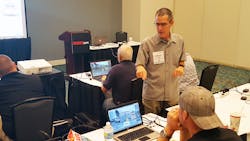FHExpo16: Simulated Firefighter Training Is Safe and Easy
NASHVILLE, TN—Computer simulation has its place in the fire service and students learned some valuable tips on how to create them during an eight-hour class at Firehouse Expo on Wednesday.
Ted Nee, a retired deputy chief from the Albuquerque, NM, Fire Department taught an interactive class on Fire Studio Instructor edition software. Participants learned highly technical skills on how to create their own fire simulations using buildings and scenes generated within their own communities.
Nee said scenario simulation is particularly good for teaching incident command and fire operations.
“Anytime you are in charge of an incident, you are under a good deal of pressure,” Nee said, adding that by using simulation, fire departments are able to create scenarios and practice them over and over until they become core abilities.
“Perfect practice makes perfect performance,” he said. “Practice doesn’t make perfect, practice makes permanent.”
The beauty of simulated training is the ease of which it can be done and the reduced risk. And, in simulation, the instructor can stop a scenario to offer some constructive feedback and the chance to redo a scenario as many times as needed to get it right.
Nee calls that mental modeling. To illustrate his point, he said that if a person had never seen a dog before, it would be difficult to explain what a dog looks like. After seeing what a dog is and being around one, individuals create mental models that allow them to recognize dogs in the future. He said the same process happens when practicing with simulation fire scenarios, adding that firefighters begin to recognize behaviors and building designs.
“It’s better to have your first mayday in a sims lab than out in the street,” Nee said.
He said simulated training provides a venue for feedback to be given.
“If they have been doing it right, tell them so they will do it again,” Nee said, adding that students also need to know when they are doing it wrong so they can prevent it from happening again.
His students created and then practiced fireground tactics with a room and contents fire in a Motel 6, two-story hotel. Nee had the students build the model with the Studio Fire software on computers they brought. Nee displayed his laptop on a projector screen and the students emulated what he was doing.
Students also learned some basic photography tips so they can take the photos they need to create a sim scenario in their own jurisdictions. He recommended taking photos on overcast days for sharper images and to take a lot from different angles to build more realistic situations.
“How often can you take a whole engine company out of service for training,” Nee said. “With sims, you can take the training to them.”
